Taking your watch on outdoor adventures can be a game changer, especially when you’re navigating the great outdoors or timing your next climb. Knowing how to maintain your watch during these adventures ensures it stays functional and reliable, even in challenging conditions.

With the right care, your watch can withstand the elements, whether you’re hiking, camping, or exploring.
Keeping it clean and checking for any signs of wear can help extend its lifespan and keep you on schedule.
Regularly clean your watch with a soft cloth
Keeping your watch clean is simple and essential, especially when you’re out in nature.
Dirt, dust, and sweat can dull its appearance and potentially affect its function.
Use a soft, lint-free cloth to gently wipe down the case and strap.
This helps remove any grime that collects during your adventures.
Make it a habit to clean your watch after a day outdoors.
For stubborn spots, slightly dampen the cloth with water.
Avoid using harsh chemicals or abrasive materials, as they can scratch the surface.
If your watch has a leather strap, be extra gentle.
Lightly clean it without soaking the leather.
This method helps keep it looking sharp without causing damage.
Ensure water resistance is intact before exposure
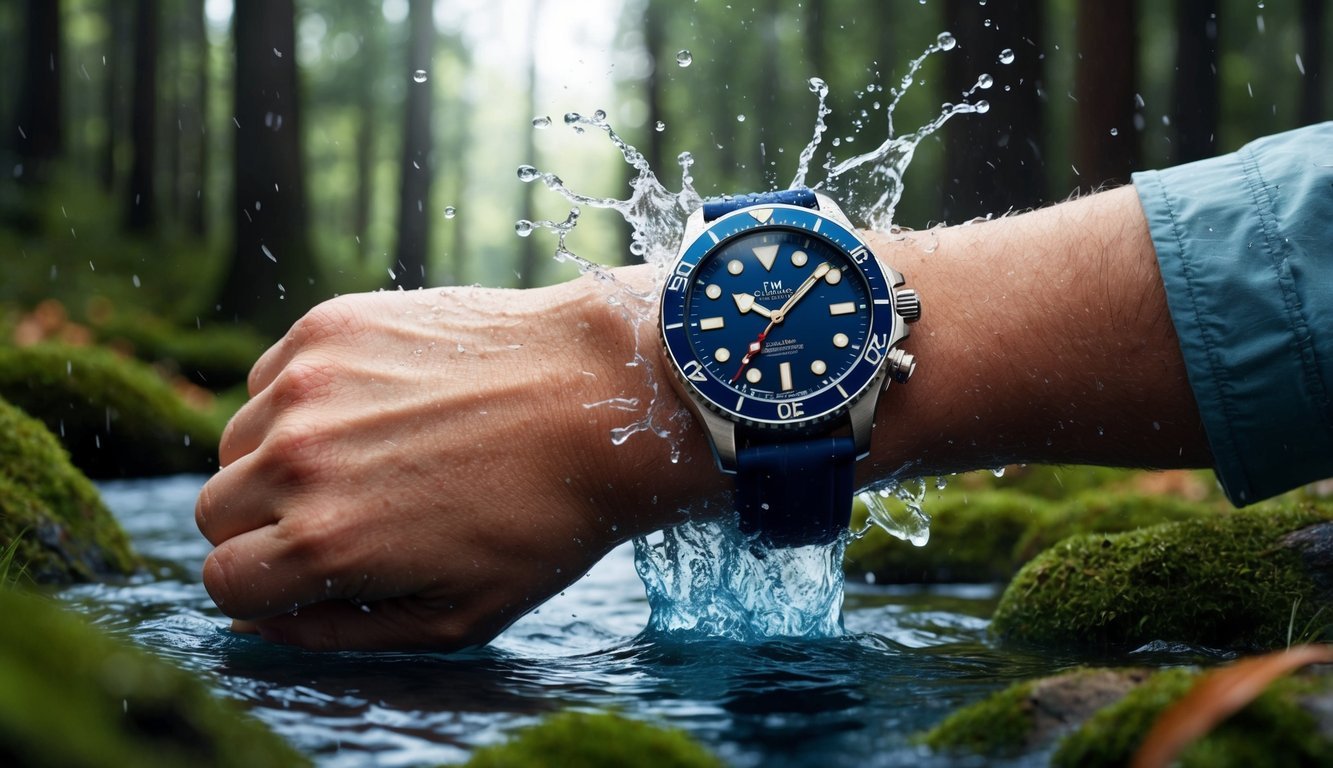
Before you head out on your next outdoor adventure, check that your watch is water-resistant.
This is crucial to protect it from unexpected weather or activities involving water.
Most watches have a water resistance rating, typically measured in meters.
Familiarize yourself with this rating; it tells you how much water your watch can handle.
For instance, a watch rated at 30 meters can withstand splashes but isn’t suitable for swimming.
Give your watch a quick visual inspection.
Look for any cracks or damage on the crystal or case.
If anything looks off, it’s better to avoid water exposure until you’ve addressed it.
It’s also smart to avoid pressing buttons or pulling the crown while underwater.
This can compromise the watch’s seals, reducing its water resistance.
Regular servicing can help maintain your watch’s water resistance.
Check with a professional if you’re unsure about its condition.
Being proactive keeps your watch safe and functional, allowing you to enjoy your adventures without worry.
3) Check the watch band for wear and tear
Taking care of your watch band is crucial, especially during outdoor adventures.
It’s the part that keeps your watch securely on your wrist, so it needs to be in good shape.
Inspect the band regularly for any signs of wear and tear.
Look for fraying, cracking, or discoloration.
Any of these issues can affect its durability and comfort.
If you’re using a leather strap, give it some extra attention.
Dirt can build up, so it’s good practice to wipe it down with a dry microfiber cloth.
When you clean it, use a slightly damp cloth with mild soap to avoid damage.
For metal bands, check for loose links or scratches.
Ensure the clasp functions properly to keep your watch from falling off.
A small amount of care goes a long way here.
4) Store in a protective case when not in use
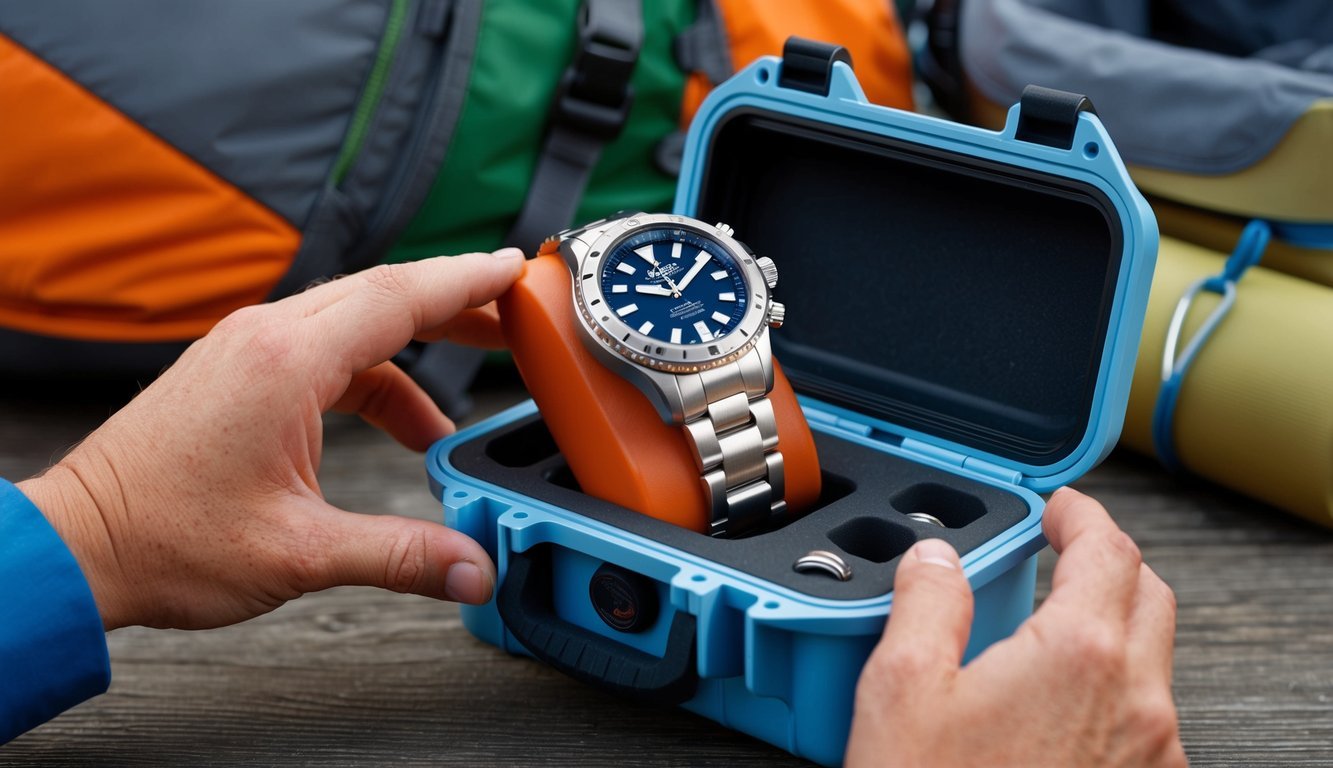
When your watch isn’t on your wrist, store it in a protective case.
This keeps it safe from dust, scratches, and accidental damage.
A watch box or case is ideal for preventing wear and tear.
Look for one with soft padding to cradle your watch gently.
If you have a collection, consider a multi-slot case.
This allows you to keep your timepieces organized while being easily accessible.
Avoid leaving your watch in direct sunlight or extreme temperatures.
Storing it in a case helps maintain the materials and functionality.
Cleaning your watch before storage is also recommended.
Make sure it’s dry and free from dirt.
5) Avoid exposure to extreme temperatures
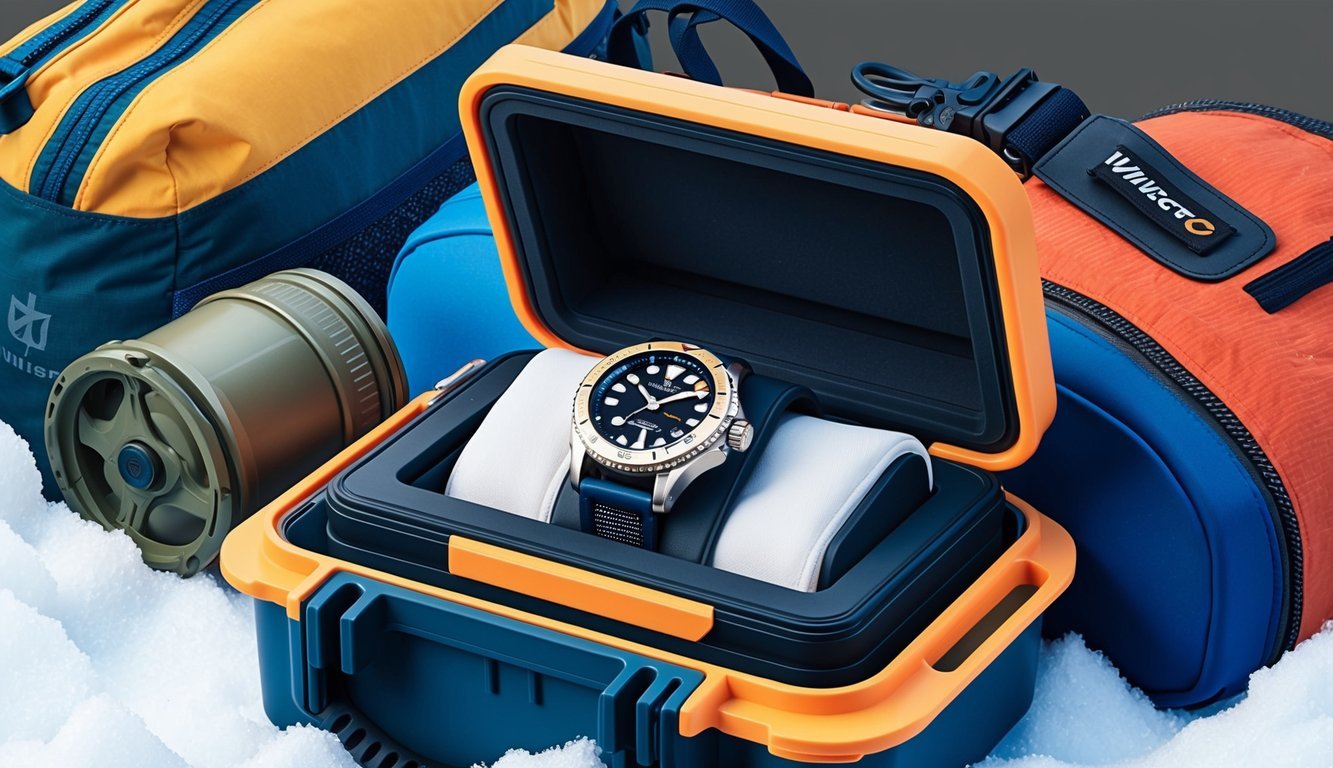
When you’re out on an adventure, keep an eye on the temperature.
Extreme heat or cold can damage your watch.
High temperatures can dry out lubricants, leading to friction and poor performance.
Plus, metal components might expand, affecting accuracy.
Cold weather isn’t much better.
It can cause battery issues and reduce the watch’s overall functionality.
If you’re in a situation where temperatures soar or plunge, consider taking your watch off.
Storing it in a cool or warm place, depending on the conditions, helps maintain its integrity.
6) Use a microfiber cloth for crystal polishing
When you’re out enjoying adventures, your watch can get scratched or smudged.
A microfiber cloth is your best friend for polishing the crystal.
Start by ensuring the cloth is clean and dry.
Gently wipe the crystal in circular motions to lift away dirt and fingerprints.
This method is gentle and won’t scratch the surface.
If there are persistent smudges or fine scratches, you can use a bit of watch-specific cleaning solution or water.
Just apply it lightly to the cloth, not directly to the crystal, to avoid any damage.
Keep your microfiber cloth stored in a safe place, ideally in a small bag or case, to prevent it from getting dirty while you’re on the move.
This ensures it works effectively whenever you need it.
7) Inspect the timekeeping accuracy periodically
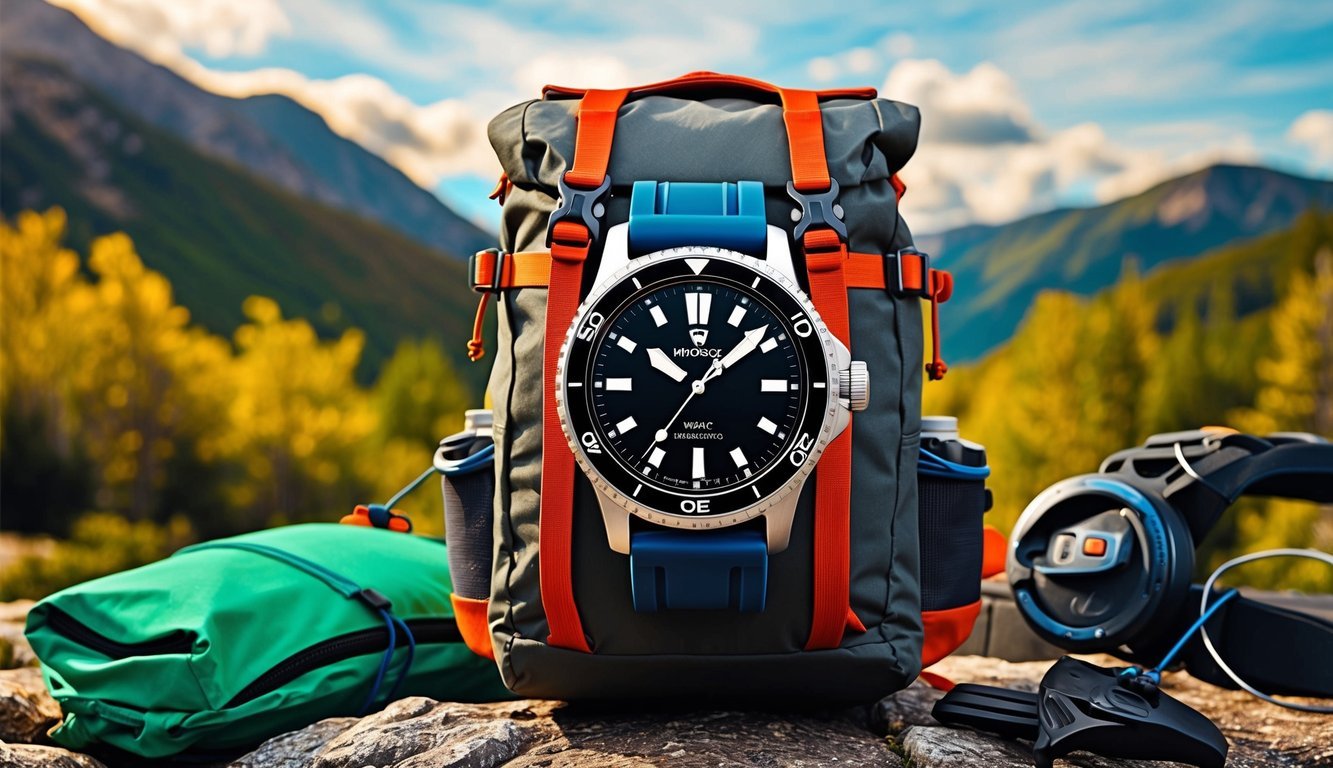
When you’re out on an adventure, your watch’s accuracy matters.
Sudden changes in temperature or physical impact can affect its performance.
It’s a good idea to check your watch’s timekeeping accuracy regularly.
To do this, set your watch to a reliable time source before you head out.
Keep track of how much it gains or loses over a few days.
This helps you spot any discrepancies.
If you notice significant time loss or gain, it might be time for a service.
Mechanical watches especially benefit from regular maintenance to ensure they run smoothly.
Keep in mind that some watches are more sensitive than others.
If you’re using a digital watch, make sure the battery is fresh and functioning properly.
8) Lubricate moving parts to prevent rust
Keeping your watch well-lubricated is essential, especially during outdoor adventures.
Lubrication helps to reduce friction between moving parts and prevents rust from forming.
You should focus on areas like gears, pivots, and escapements.
These parts are susceptible to moisture when you’re out and about.
Using a small amount of proper lubricant can make a significant difference.
When applying oil, use the right tools.
Precision oilers help apply just the right amount without excess.
Too much oil can attract dirt and moisture, leading to more problems.
Be mindful of the types of oil you use.
Watch-specific lubricants are designed for optimal performance and rust prevention.
Make sure to apply thin films rather than large drops to avoid complications.
Regularly check your watch, especially after exposure to elements like rain or sweat.
A quick maintenance session can keep it running smoothly and extend its lifespan.
9) Regularly test the luminous dial visibility

When you’re out in the wilderness, having a watch you can read in low light is essential.
Regularly testing the visibility of your watch’s luminous dial will help you ensure it’s functioning as expected.
Start by exposing your watch to bright light for a few hours.
This helps recharge the luminous material.
Then, check how well it glows in the dark.
If you notice that the luminosity is fading, it might be time to consider re-luming the hands and dial.
Various methods are available, including professional services or DIY kits if you’re feeling adventurous.
Always keep in mind that some luminous materials, like radium, have a limited lifespan.
They might no longer glow after several decades, even if they were once bright.
If your watch is vintage, make sure to understand its specific luminous properties.
10) Avoid Chemical Contact Especially Sunscreens
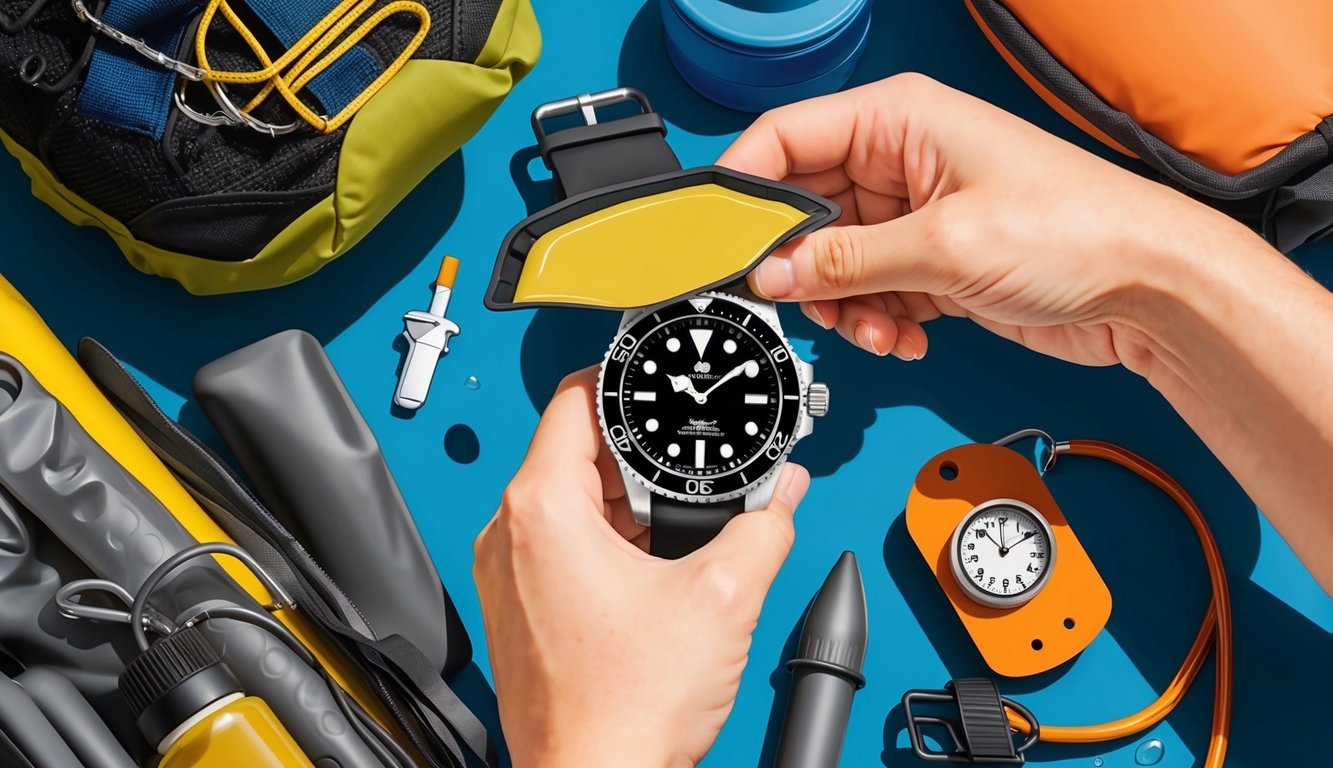
When enjoying the outdoors, be mindful of the chemicals in sunscreens.
These products can contain harsh ingredients that may damage your watch’s materials, especially if your watch has a leather strap or specific coatings.
Try to apply sunscreen before putting on your watch.
This minimizes the risk of direct contact and keeps your timepiece looking its best.
If you need to reapply sunscreen while wearing your watch, consider using a towel to gently cover it.
This will protect the watch from any chemical residue.
After your adventure, it’s a good practice to clean your watch with a soft, dry cloth.
Remove any sunscreen traces, even if you think it didn’t come into contact directly.
Taking these precautions will help preserve the functionality and appearance of your watch.
Enjoy your outdoor activities without worrying about potential damage.
Understanding Your Watch’s Outdoor Features
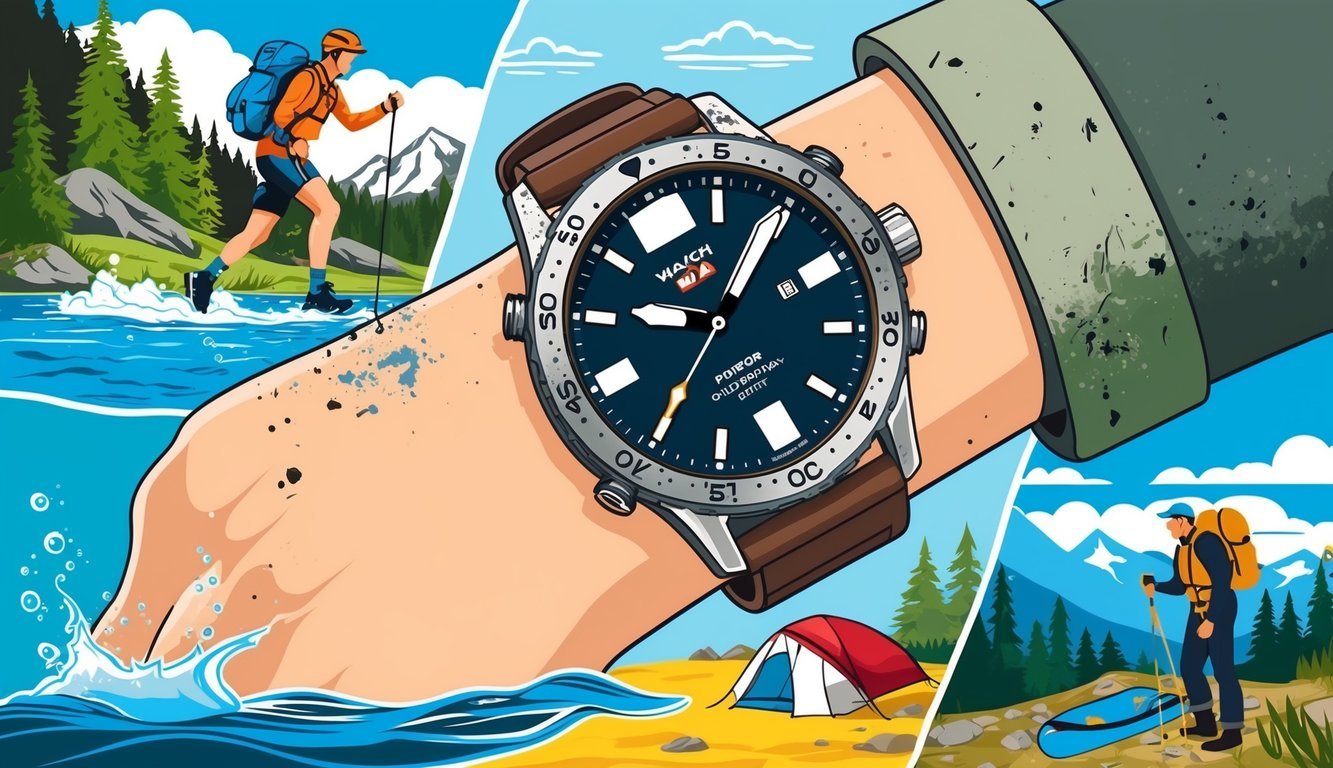
When you head outdoors, you need to know the features of your watch that enhance your experience.
Understanding water resistance and durability can help you choose the right activities without worry.
Water Resistance
Water resistance defines how much water your watch can handle.
Look for the ATM rating to understand this better:
- 3 ATM: Resistant to splashes and light rain.
- 5 ATM: Suitable for swimming but not diving.
- 10 ATM or more: Safe for diving and heavy water activities.
Always check your watch’s specifications.
If you’re kayaking or hiking in the rain, a higher water resistance rating is vital.
Also, remember to regularly check seals and gaskets, as wear can reduce water protection.
Durability and Materials
The materials used in your watch determine its durability.
Outdoor watches typically feature robust components.
Here are some materials to look for:
- Sapphire Crystal: Scratch-resistant and tough.
- Stainless Steel: Provides weight but offers great durability.
- Polymer or Resin: Lightweight and shock-resistant.
Pay attention to features like shock resistance and mineral glass.
These elements ensure your watch withstands nicks and bumps while trekking or climbing.
Investing in a durable watch not only ensures reliability but enhances your outdoor experience.
Cleaning and Caring for Your Watch
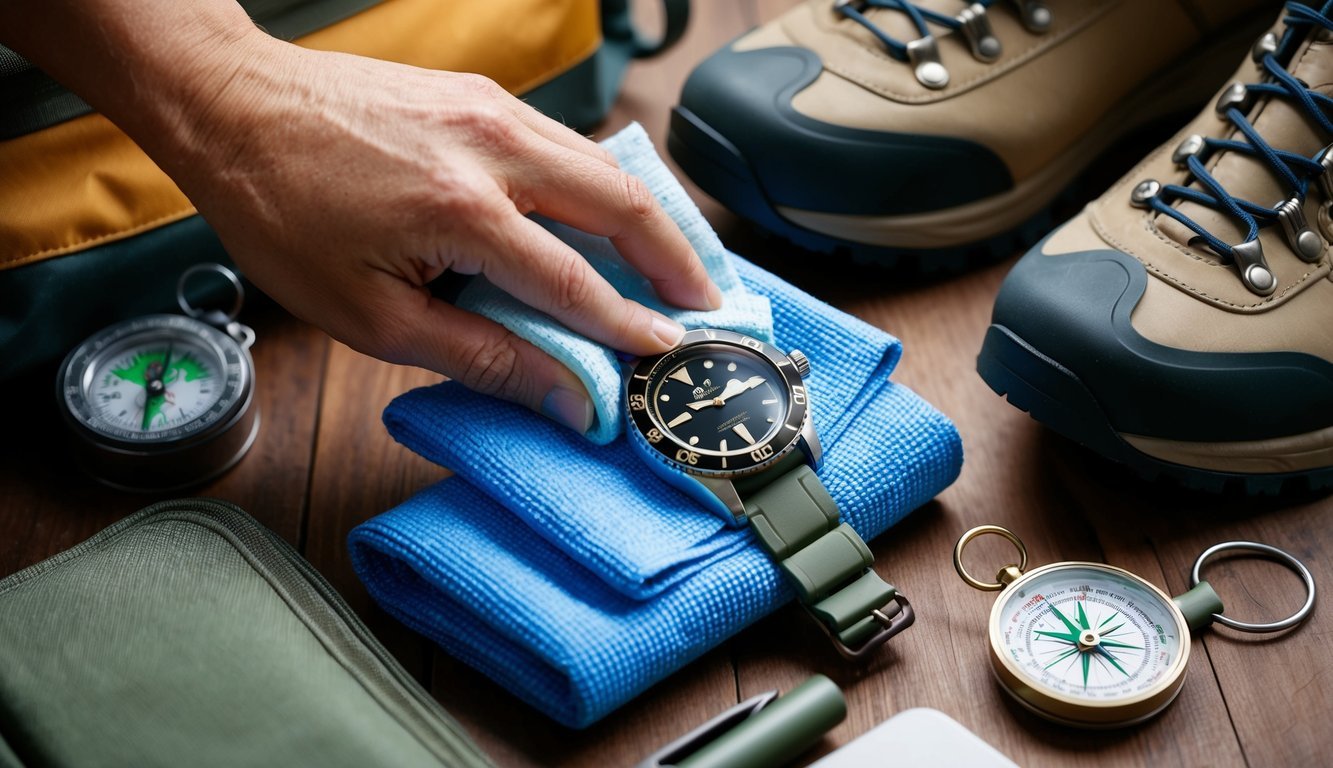
Keeping your watch in great shape during outdoor adventures is essential.
Regular care and proper cleaning will help ensure your timepiece remains functional and stylish, no matter the conditions.
Regular Maintenance Tips
To maintain your watch, start with simple, regular cleanings.
Use a soft, dry cloth to wipe down the watch face and strap.
If your watch is water-resistant, you can lightly dampen the cloth for a more thorough clean.
Avoid using harsh chemicals that could damage the finish or materials.
Additional maintenance tips:
- Check the seals: Ensure any gaskets or seals are intact to keep dirt and moisture out.
- Keep it dry: After exposure to water or sweat, dry your watch promptly to prevent corrosion.
- Store wisely: When not in use, keep your watch in a designated box or pouch to protect it from scratches and impacts.
Dealing with Sand and Dirt
If you’re adventuring in sandy or dusty environments, your watch will need special attention.
Sand can get into the crevices of the watch, potentially damaging internal components.
Tips for cleaning sand:
- Rinse lightly: If possible, rinse your watch under fresh water to dislodge sand particles.
- Use a soft brush: Employ a soft-bristled brush to gently scrub the strap and case, focusing on nooks and crannies.
- Dry carefully: After cleaning, dry your watch with a microfiber cloth to prevent scratches and moisture buildup.


